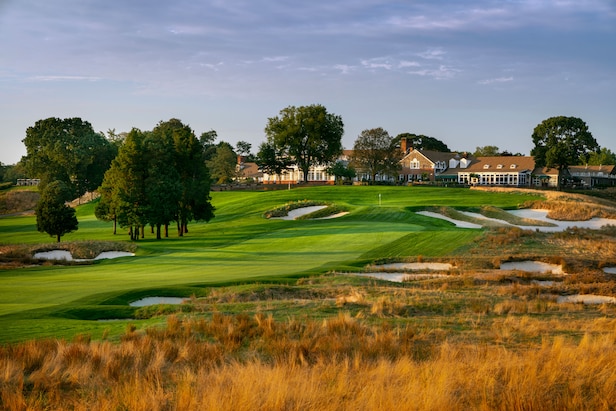There’s an old golf platitude about Cypress Point being the greatest 17-hole course in the world. The layout is nothing but dazzling from the first tee onward. Then you play the 18th, tacking narrowly back through the cypress toward the clubhouse, a relative letdown, folks will say.
RELATED: Ryder Cup 2025: 15 moments that made the Ryder Cup golf’s most compelling duel
The same scenario also applies to the Black Course at Bethpage State Park in New York, site of this week’s Ryder Cup Matches. Playing Bethpage is a gladiatorial fight full of powerful par 4s, slanting and offset fairways barely 25 yards wide, deep rough and small, perilously quick greens. It’s a spellbinding arrangement of hazards, obstacles and intimidation, but when you arrive at the elevated 18th tee, the competition seems to have already ended.
Your browser does not support the video tag.
At just over 400 yards from the championship tees the hole is more of a bowling alley than anything, arrow straight with two opposing fields of grassy bunkers flanking the slender lane. There is no option other than to hit a straight tee shot, so the choice is essentially to club down for control (like the 6-iron Lucas Glover hit on the 72nd hole of the 2009 U.S. Open), or for longer players to take them out of play by driving past them and wedging on, even if in the rough.
In stroke play it’s an anticlimactic hole—on a course where there are no other easy pars, good players can usually make a routine 4 using either tactic.
RELATED: Ryder Cup 2025: Will this be the hardest hole at Bethpage Black?
Avoiding the fairway bunkers is the real trick—according to strokes gained analysis, there’s only an 8 percent chance of making birdie when players drive into them off the tee. Skilled players know to avoid them at all costs and can game plan around them.
But without the threat of big scores found elsewhere on the Black, tournaments and matches too often end with those in the lead hitting an iron off the tee, then a short iron onto the elevated green with gentle back-to-front slope. It delivers all the late-game drama of a team taking a knee and running out the clock.
RELATED: The best golf courses in New York
A good final hole for a match play setup should be volatile and tantalizing, where the length and arrangement of hazards readily leads to both birdies and bogeys. Unfortunately, the distance of Bethpage Black’s 18th, 411 yards, falls into a kind of no man’s land for Ryder Cup players, not long enough to get them into trouble and not short enough to tempt them into a major gamble.
One solution for the Ryder Cup would be to push the tees as far forward as they can be set up. That would shorten the length of the hole to approximately 320 yards to the front of the green. At this distance, it’s less likely players will play conservatively off the tee. Even those who don’t have the firepower to carry their drives all the way to the putting surface would be more enticed to hit their tee shots as close to the green complex as they can and trust they can scramble for a pivotal birdie.
The calculation is that the odds of getting up and down increase the closer they are to the green on their second shots. Competitors successfully convert from the bunkers surrounding the green 42 percent of the time, and they’d much prefer to be doing it on their second shots than their third. Moving the tee up may not increase the bogey count but would certainly produce more birdies and therefore more unpredictable results.
Kerry Haigh, chief championships officer of the PGA of America, the host organization of the Ryder Cup, told Golf Digest that this shortened setup at the 18th is possible but not likely since only 39 percent of Ryder Cup matches make it to the final hole (going back to 1985).
That might be true, but those matches that do make it to the 18th are all closely contested ones that still hang in the balance. With vital points and half points at stake, the deciding hole should be one that rewards heroic action and makes the players execute brave shots in pressure packed situations.
Haigh notes that if the setup committee decides to move tee forward, they will notify the captains ahead of time and give the teams a look at the tee during practice rounds. We’ll know early in the week if they’re serious about considering this option. Let’s hope they do—it can turn an ordinary finishing hole at the Ryder Cup into a dramatic one.
RELATED: 5 public courses that could be transformed into major championship venues
This article was originally published on golfdigest.com

